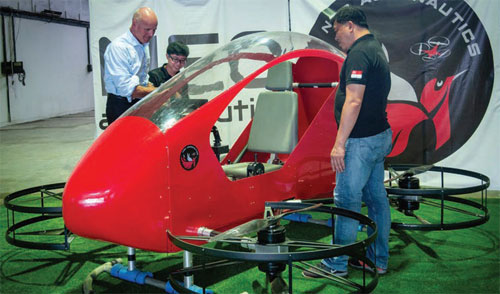By Brice Wallace
If a Singaporean company has its way, in a few years people will look up in the sky and see not a bird, not a plane, but instead a bunch of PAVs.
That company, NEO Aeronautics, is getting help from Utah state government in its quest to test and deploy PAVs, or personal air vehicles, which are single-person flying machines that it hopes will be used in low-level flights in 25 U.S. cities by the year 2025.{mprestriction ids="1,3"}
NEO recently announced that the Utah Department of Transportation’s Division of Aeronautics will collaborate with the company through the testing, certification and deployment of its Crimson S8 vehicle. The collaboration will feature the division connecting the company with government and private-industry partners.
The division has a strategic initiative to make urban air mobility, or UAM, a reality through the development of a state-supported UAM infrastructure system, which includes the testing of aerial taxis and PAVs in current and future flight corridors. “Utah’s UAM initiative, while in its infancy, is very much aligned with NEO Aeronautics’ vision of developing UAM communities through the deployment of safe, reliable and affordable PAVs,” said the company, which was incorporated in 2018.
“Urban air mobility is an exciting evolution in the development of ‘Keeping Utah Moving.’ UDOT is a leader in transportation innovations and this is no exception,” said Jared Esselman, Utah’s director of aeronautics.
Testing and certification for the Crimson S8 is scheduled to take place in the 2020 second quarter, with site identification and deployment scheduled for the 2020 fourth quarter.
The Crimson S8 is a single-seat, electric-powered vehicle capable of vertical takeoff and landing. Company-supplied details indicate the 254-pound vehicle — sporting a frame of aluminum and composite materials — is about 9 feet long, 9 feet wide and a little more than 5 feet tall, enabling it to occupy a single space in a parking lot. It is designed to fly up to 50 feet from the ground at 50 mph, with initial flights expected to last about 15 minutes and have a 12.5-mile range, although the company hopes to reach a one-hour flight time. It can carry up to 220 pounds, operates with a joystick and throttle, and has a touchscreen display and four propellers.
The Crimson S8 is an ultralight vehicle. The Federal Aviation Administration’s Part 103 regulations define an ultralight as a vehicle with a single seat, that is used for recreational or sport flying, has a top speed of about 63 mph, and weighs less than 254 pounds if powered. Operators are not required to meet any aeronautical knowledge, age or experience requirements and the vehicle cannot be flown after any congested area of a city or town or over any open-air assembly of people.
“NEO Aeronautics is privileged to collaborate with Utah for the flight test certification and the potential deployment of the Crimson S8 PAV,” said Neo Kok Beng, the company’s founder and CEO. “The Crimson S8 conforms to FAA Part 103 category, allowing the development of UAM communities as minimal training is required to operate the PAV. In addition, we are committed to contribute to the community through our social mission of reaching out to youth based on our STEM outreach program.”
Carlos Braceras, executive director of UDOT, last week visited the company’s research and design facility to see the developmental model of the Crimson S8 and other projects.
“This visit further enhances our long-term vision of building UAMs for the communities,” Neo said. “We look forward to having our production model deployed in Utah in 2020, and to expand beyond Utah.”
That facility has been used for indoor trials without an operator, according to The Straits Times. Outdoor flights by PAVs are prohibited in Singapore.
Media reports indicate the company envisions the Crimson S8 to be available for flights under a membership model. Neo has said the cost of using it will be comparable to that of a taxi in the U.S., according to Today.
Company officials have said the vehicle will be able to fly on autopilot or controlled by an operator, will be as simple to operate as a drone, and will require members only to undergo simulations and a brief training session before flying.
Using what is called “geo-fencing,” the vehicle would be automatically forced to land if it travels outside a certain geographic area.
The company hopes to have 1,000 vehicles flying in 25 U.S. cities by 2025.{/mprestriction}








